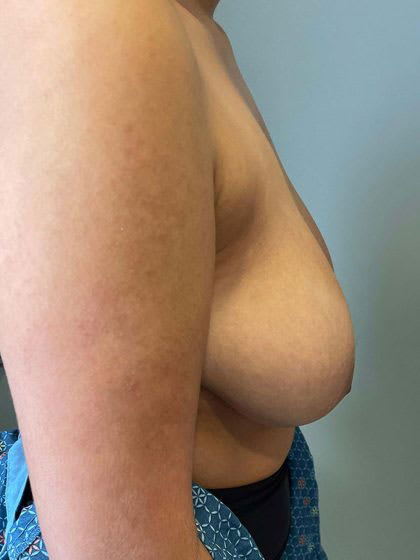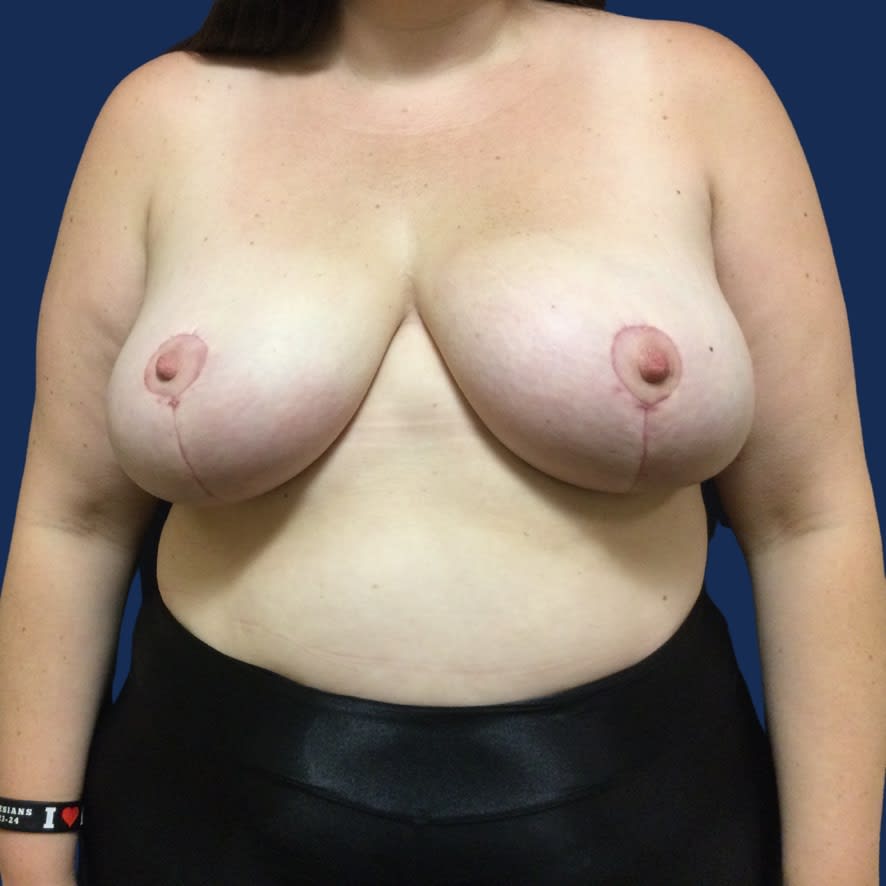
The Skinny
Overview
Most girls grow up believing that “bigger is better” when it comes to their breasts. It takes several formative years to realize that this is a myth. There are more aspects involved in your breast appearance and breast satisfaction than size alone. The older a woman becomes, the more she understands that the shape, contours, evenness, and proportions also make a difference in how she feels about her breasts. Some women do wish their breasts were larger, of course, but just as frequently you will find that other women wish their breasts were smaller. This desire can stem from several points of origin, but according to the American Society of Plastic Surgeons, the root concern in women requesting breast reduction surgery comes from “disproportionately large breasts.” This means that the breast size is considerably larger than the rest of the body, causing a noticeable difference in body proportions. Having breasts that are disproportionate to the rest of the body can cause discomfort and mental distress. There is a physical and emotional component to breast size, and sometimes, the best way to address issues caused by large breasts is through breast reduction surgery.
Breast reduction surgery, formally referred to as reduction mammaplasty, works to restore proper proportions to your breast size by removing excess breast fat and glandular tissues from the breast. This will improve your body shape while also addressing discomfort related to breast size. These discomforts, as well as breast reduction surgery itself, will be discussed in further detail throughout the article.
AEDIT
Before & After Images by Provider
This Album Contains Explicit Content. Sign up or Login to Browse Real Before & Afters
Before & After Images by Provider
Breast Reduction (Reduction Mammaplasty) Solutions
The Specifics
Would I be an Ideal Candidate for Breast Reduction Surgery?
Emotional Considerations: If the size of your breasts makes you feel self-conscious or uncomfortable, you may be an ideal candidate for surgical breast reduction surgery. Reducing the size of your breasts may help improve your overall self-image. Bear in mind that you may need additional procedures such as a breast lift or an implant to enhance the shape, volume, and “perkiness” of your breasts.
Physical Considerations: It is not uncommon for those with large breasts to experience physical discomfort and pain associated with their disproportionate size. The extra weight your breasts carry may cause back pain, neck pain, and shoulder pain that can only be alleviated through surgery. Large breasts can also cause skin irritation to occur beneath the breast crease and may interfere with your ability to participate in physical activities. For example, something as simple as running can cause a great deal of discomfort for those with large breasts because the weight of the breasts causes them to pull down, bounce, and possibly even tear. You may find, too, that sports bras provide little support. Similarly, the weight of heavy breasts can cause regular bra straps to cut into the skin necessitating surgery to improve physical comfort.
Who Would Not be an Ideal Breast Reduction Candidate?
Breast reduction surgery is not recommended for those who are under the age of 18 as your body may still be developing. It is also not recommended for those who are pregnant, breastfeeding, or who plan to breastfeed in the future.
What are the Pros and Cons of Each Procedure?
Pros of Breast Reduction Surgery: Breast reduction surgery offers permanent and immediately noticeable results in both the shape and size of your breasts. With this method, the surgeon can reconstruct the breasts by surgically lifting them, adding shape or volume via implants, and create perkier youthful breasts while also reducing their original size. This method is also useful for those who need their breast size reduced by more than 50 percent.
Cons of Breast Reduction Surgery: The downsides of breast reduction surgery include the longer recovery time, visible scarring, and the chance of negatively impacting your results through significant weight gain, weight loss or pregnancy.
Pros of Liposuction for Breast Reduction: Liposuction provides the advantages of rapid recovery and minimal scarring. It also carries very little risk of complications and can generally be performed by only using local anesthesia rather than general anesthesia.
Cons of Liposuction for Breast Reduction: Liposuction only focuses on reducing the size of the breast. Fat reduction will likely result in a slight lift of the chest, but it will not provide the same results as a breast lift. Similarly, liposuction for breast reduction does not offer the opportunity to enhance the shape of your breasts. This procedure will only result in a smaller form of your original breast shape.
What is the recovery like?
To better understand the healing and downtime associated with the procedure, check out our complete guide to breast reduction recovery.
Are There Side Effects Involved with Having a Breast Reduction?
Side effects to a breast reduction surgery include the normal after-effects of swelling and bruising, as well as tightness and changes in sensation. You also run the risk of uneven breasts and visible scarring. Scars will fade over time, but unevenness will need to be surgically corrected.
Liposuction carries very little in the way of side effects, but it will not provide the same drastic changes as breast reduction surgery.
Cost
Breast reduction surgery will cost between $6,500 - $12,000, depending on your surgery type, surgeon’s fees, anesthesia, insurance coverage, any complications or additional procedures, and your geographical area. To learn more about the total cost of the procedure, check out our complete guide to breast reduction costs.
What Can I Expect During My Breast Reduction Surgery?
Breast reduction surgery focuses on removing excess fatty tissue in heavy breasts by using one of three incision methods deemed most appropriate for the specific needs of each patient. These incision methods include the peri-areolar, vertical, and inverted T methods.
The Peri-areolar Incision Method The peri-areolar or “donut” lift is ideal for those who only require a mild reduction and lifting. This surgery creates a circular, donut-shaped incision around the areola and a larger concentric circle around the breast itself. The apex of the second circle will be the new location of the nipple once the surgery is complete. The skin and excess fat found between the two circles will be removed before closing the incision. Once complete, you will have a smaller areola, and smaller, perkier breasts. The scar will be hidden along the areola border.
The Vertical Incision Method The vertical incision, or “lollipop”, method is ideal for those whose sagging and breast shape concerns are moderate. During this method, the above-mentioned peri-areolar incision is joined by an incision that goes from the bottom of the areola to the breast fold. The skin will be removed from this area, resulting in a keyhole shape. Once the incisions have been closed, excess tissues and fats will be removed as well. The lines from this incision method leave behind a visible lollipop scar.
The Inverted T Incision Method The inverted T incision method, also referred to as the “anchor” incision method is likely to provide the best results for those experiencing severely sagging, large breasts. This method utilizes the vertical incision technique with the addition of a horizontal incision along the breast fold. This incision creates an anchor-like scar that will remain visible even after the breast tissues are removed and the incisions are closed.
Breast Reduction by Liposuction Another method of breast reduction that you may want to consider is the option of breast reduction by liposuction. This option is ideal for older or overweight women who hold a large amount of fat in their breasts, and who are more concerned with the size of the breast rather than the shape. It is also for those who only wish to see their breast size reduced by about 50 percent. While this method offers a shorter recovery time, little pain, and minimal (if any) scarring, it will not give you the same advantages as a surgical method. For example, you may notice a lift in your breasts due to their smaller size, but they will not be reshaped or enhanced. Instead, they will be a smaller version of your current breasts. If that will work for your overall goals, liposuction may be a great option for you.
According to the US National Library of Medicine, the efficiency and usage of liposuction have caused it to become “the most common surgical procedure in plastic surgery over the past two decades.” Liposuction effectively creates smaller breasts by removing the extra fat deposits contributing to the large size of the breast. It only requires local anesthesia to be performed. During a liposuction breast reduction, tumescent fluid is injected into small incisions in the skin to swell and firm the target area. This gives your surgeon greater control over the extraction process. It also temporarily constricts blood vessels which helps prevent blood loss and reduce pain, bruising, and swelling. Following the injection of tumescent fluid, your surgeon will insert aspirating cannulas into the incisions. These are used to suction out the fat. The process itself is minimal time consuming and requires very little downtime.
The Takeaway
Conclusion: How to Choose a Surgeon to Perform Your Procedure
Whether you are leaning towards a surgical breast reduction or a reduction via liposuction, who you choose to perform your reduction will impact your experience. It is highly important that you seek out a board-certified surgeon with significant exposure to breast reductions.
With both breast reduction surgery and liposuction for breast reduction, you will need to have realistic expectations. You may deal with scarring or have long-term issues related to the look or shape of your breasts. Overall, though, reducing your breast size will enhance your confidence and decrease physical issues such as back, neck and shoulder pain.












